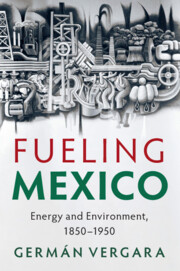Book contents
- Fueling Mexico
- Studies in Environment and History
- Fueling Mexico
- Copyright page
- Contents
- Figures and Tables
- Acknowledgments
- Introduction Energy, Environment, and History
- Chapter 1 1850s: Solar Society
- Chapter 2 The Nature of Capitalist Growth
- Chapter 3 Searching for Rocks
- Chapter 4 The Other Revolution
- Chapter 5 1950s: Fossil-Fueled Society
- Conclusion
- Bibliography
- Index
Introduction - Energy, Environment, and History
Published online by Cambridge University Press: 11 June 2021
- Fueling Mexico
- Studies in Environment and History
- Fueling Mexico
- Copyright page
- Contents
- Figures and Tables
- Acknowledgments
- Introduction Energy, Environment, and History
- Chapter 1 1850s: Solar Society
- Chapter 2 The Nature of Capitalist Growth
- Chapter 3 Searching for Rocks
- Chapter 4 The Other Revolution
- Chapter 5 1950s: Fossil-Fueled Society
- Conclusion
- Bibliography
- Index
Summary
Picture Mexico in 1850. The majority of Mexicans lived in villages and practiced some form of agriculture and animal husbandry: slash and burn in the tropical lowlands; rain-fed agriculture in the temperate central highlands and the Bajío; and a mix of ranching and limited irrigation in the arid north. Humans and animals powered every stage of food production. Urban centers were small, few, and far between. Of the country’s seven and a half million people, no more than one in twenty lived in a city. Trade and travel depended on human and animal muscle power. Manufacturing took place in small urban workshops or river-powered factories. Like other agrarian societies, population and economic growth were slow and subject to periodic declines. Despite enormous disparities between regions, classes, genders, and races, all mid-nineteenth-century Mexicans lived in a world of low energy consumption where life’s necessities came from the land.
- Type
- Chapter
- Information
- Fueling MexicoEnergy and Environment, 1850–1950, pp. 1 - 15Publisher: Cambridge University PressPrint publication year: 2021

